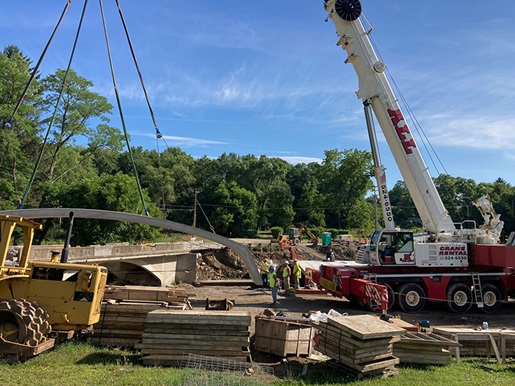Precast concrete is an increasingly popular option for constructing bridges, buildings, and many other projects involving heavy lifting. Thanks to benefits like the speed of construction and durability, the precast concrete market is
expected to double from 2024 to 2033.
As precast’s popularity continues to rise, it’s more important than ever to have the right crane solution to efficiently and successfully execute your job. ALL Crane works closely with general contractors to do just that. This includes highlighting one of the most significant aspects of a successful precast job – the layout.
Here are three tips that businesses can follow to set their precast job up for success.
1. Lay Out The Job Sequence In Advance
Before you invest in a crane, it’s important to determine the best way to approach your project. Each crane can affect numerous variables on a job site ranging from setup to site access. For example, you’ll typically need to plan for multiple setups with a larger crane, while a smaller crane may offer more maneuverability in exchange for lift capacity.
Laying out job sequencing allows you to examine different scenarios and decide which crane solution is most practical and productive for your specific job. ALL Crane uses software to review different crane options, the optimal order for different tasks, and other factors to determine a lift plan catered to a specific project.
Once you decide on a specific approach, it’s time to create a detailed work plan for that project. This plan can help you outline different aspects of the project, such as load weights and lift radius, and organize them by lift day, load, or some other criteria. Having all this information planned out and documented can help keep crane operators and other pertinent individuals informed to maintain efficiency and set up a project for success throughout the job.
2. Lay Out The Crane
An optimal crane layout plays a key role in maximizing productivity. The way that you set up your crane and anything that crane needs affect just how easily and quickly operators can do their jobs. The following suggestions can help you improve your crane layout and eliminate future issues.
- Don’t automatically take the crane to max capacity. A dynamic load can actually improve productivity if the percentage of capacity is reduced. Plan your crane layout to give yourself a buffer instead of maxing out the crane.
- Factor in mobility on site. Crane layout can affect how well equipment can move, so maintain the ability to adjust counterweights and other equipment to allow the crane to move as needed without added work or steps.
- Consider how the crane will pick up precast loads. Certain loads, such as large panels, may require a specific setup to avoid collisions or rigging disruptions.
3.Lay Out The Jobsite
In addition to laying out the crane and the job sequence, it’s also essential to consider site access. You’ll need to prepare the site for not only crane delivery, but also the precast products themselves.
The more you can plan ahead and lay out your job site to accommodate efficient transport and unloading, the better. A strategic setup can help cut unnecessary booming that adds time and other issues. For example, if you’re setting precast 80 feet from a building, consider having the truck loaded with the product to be 80 feet away from the crane on the other side. This setup allows the operator to simply swing back and forth without having to boom up or down, and work more efficiently.
By addressing these three different kinds of layouts, your organization can get the most out of each project and feel more confident in the work that needs to be done. Partner with ALL for the quality equipment, lift planning, and service you deserve for your jobs.

